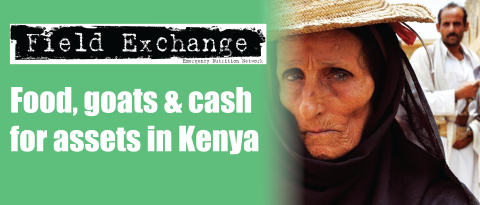Nutritional support services and HIV in sub-Saharan African countries
Summary of research1
On the basis of the latest WHO criterion for HIV treatment initiation (CD4 cell count =350 cells/mm³), anti-retroviral therapy (ART) was accessed by an estimated 37% of sub-Saharan Africans in need of ART by the end of 2009. A significant proportion of people living with HIV/AIDS in the region are simultaneously affected by nutritional deficiencies. Cross-national population-based data suggest that the prevalence of mild and moderate malnutrition among adults living with HIV/AIDS is 15.4% and 10.3% respectively, in sub-Saharan Africa, and is also elevated among young children living in AIDS-affected households. The disproportionate burden of HIV/AIDS and nutritional deficiencies in sub-Saharan Africa is of particular concern as each condition may perpetuate and aggravate the severity of the other.
In order to mitigate the adverse effects of food insecurity on HIV outcomes, international organisations such as the WHO, the Joint United Nations Programme on HIV/AIDS, the World Food Programme (WFP) and major HIV initiatives such as the US President’s Emergency Plan for AIDS Relief (PEPFAR) recommend the integration of nutritional support services, specifically nutrition assessment, education and counselling, into HIV/AIDS treatment and care programmes. Accordingly, PEPFAR have allocated $US130 million to support the integration of HIV and nutritional support services. Since 2006, PEPFAR implementation guidelines have recommended the provision of nutritional evaluation and food support to all orphans and vulnerable children, to HIV-positive pregnant and lactating women and to all adults receiving ART with clinically defined malnutrition. However, little is known about the extent to which nutritional support services are available in HIV care and treatment programmes across sub-Saharan Africa.
A study conducted in 2008 (but only published recently) set out to examine the availability of nutritional support services in HIV care and treatment sites across sub-Saharan Africa. The study conducted a cross-sectional survey of sites providing ART in nine sub-Saharan African countries. Outcomes included availability of: (i) nutritional counselling, (ii) micronutrient supplementation, (iii) treatment for severe malnutrition and (iv) food rations. Associations with health system indicators were explored using bivariate and multivariate methods.
A total of 336 HIV care and treatment sites, serving 467,175 enrolled patients, were surveyed. Of these, 303 sites offered some form of nutritional support service. Nutritional counselling, micronutrient supplementation, treatment for severe acute malnutrition (SAM) and food rations were available at 98%, 64%, 36% and 31% of sites respectively. In multivariate analysis, secondary or tertiary care sites were more likely to offer nutritional counselling (adjusted OR (AOR): 2.2, 95% CI 1.1, 4.5). Rural sites (AOR: 2.3, 95% CI 1.4, 3.8) had increased odds of micronutrient supplementation availability. Sites providing ART for >2 years had higher odds of availability of treatment for SAM (AOR: 2.4, 95% CI 1.4, 4.1). Sites providing ART for >2 years (AOR: 1.6, 95% CI 1.3, 1.9) and rural sites (AOR: 2.4, 95% CI 1.4, 4.4) had greater odds of food ration availability.
The study authors made a number of observations about the results. Although 90% of sites had at least one form of nutritional service, the type of nutritional support service reported to be available varied substantially, including by country, geographical context (urban/rural) and site-level characteristics (type of site, age of programme, reported presence of a nutritionist on staff ).
They also observed the encouraging fact that nutritional counselling to adults and to pregnant and lactating mothers was reported to be available at 95% and 91% of sites, respectively. Nutritional counselling is considered to be a cornerstone of HIV treatment support, recommended by multiple international guidelines. It is also important for supporting HIVaffected households. Studies in sub-Saharan Africa have found that HIV-exposed but uninfected children have poorer growth compared with HIV-uninfected children, possibly because of reduced breastfeeding practices by HIV-infected mothers.
Although some type of micronutrient supplementation was reported to be available at 64% of sites, this mostly included vitamin A and iron supplementation. The fact that multivitamin and mineral supplementation was reported to be available at only 25% of HIV care and treatment sites suggests that there is room for improvement. Studies have found that many people living with HIV/AIDS suffer various micronutrient deficiencies and have increased micronutrient needs. However, evidence of the effectiveness of micronutrient supplementation on HIV-infected adults and children remains limited, and findings have been varied.
Food rations were reported to be available at 31% of HIV care and treatment sites. Studies have noted that provision of food rations may be associated with improved medication adherence and retention in HIV care and treatment in sub-Saharan Africa, which is both a major and persistent challenge of scale-up in the region.
The fact that treatment for SAM is more likely to be available at sites that had been providing ART for more than 2 years may reflect the increased logistic capacity of longer established sites. The study also found that availability of treatment for SAM has expanded significantly over a short period which suggests that ART treatment and care sites may be distributing Ready to Use Therapeutic Foods (RUTF). This is promising given that RUTF use has been associated with rapid weight gain, improvements in physical activity and increased uptake of voluntary counselling and testing (VCT) and ART services among HIV-positive individuals with SAM.
The authors acknowledge that a major limitation of the study is that information was only obtained on availability of different types of service and not on the access, quality, comprehensiveness or coverage of the indicated services at the sites. They conclude that further efforts are therefore urgently needed to determine uptake, quality and effectiveness of these services and their impact on programme outcomes such as adherence to ART, retention in care and survival.
1Anema.A (2011). Availability of nutritional support services in HIV care and treatment sites in sub-Saharan African countries. Public Health Nutrition: 15 (5), 938-947
Imported from FEX website


